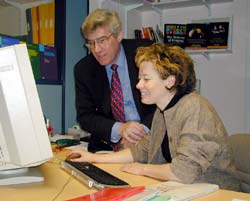Mammoth project reveals frozen secrets

Jerry Cowhig, Managing Director of Institute of Physics Publishing and Professor Kathy Sykes, Collier chair of public engagement of science and engineering at Bristol University, are searching the online IOP Journal Archive. Every journal article published by the Institute of Physics since 1874 is now available to subscribers
Which way does a mammoth skeleton point in Siberia? No, it’s not a Christmas cracker joke. To find the answer you have to look in a rather surprising place – the Institute of Physics’ new online archive.
In an article published in the first edition of Proceedings of the Physical Society in 1874, John Rae writes about the physical properties of ice and mammoth remains. He put forward a theory as to why so many of the mammoth skeletons found near the Yenesei river in Siberia had been found with their heads pointing southwards. He said that if these mammoths died in or near the river, their bodies would get swept down the river to the shallow area near the mouth. The mammoth’s head, weighed down by its tusks and skull, would drag along the bottom and in shallow water the body would still float with the current – in a similar way to a boat pulling on an anchor. When the river froze in winter, the mammoths would become frozen in this position – with their heads pointing southwards with the flow. As this river flows from south to north, the heads would be pointing southwards when they froze.
This fascinating article can be accessed for the first time on the World Wide Web on the IOP Journal Archive. Every journal article published by the Institute of Physics since 1874 is now available to subscribers – that is over 500 volume-years of journals, over 100,000 articles and over one million pages of scientific research.
“This was a massive project, and it will significantly benefit research in physics and maintains our long tradition of innovation in electronic publishing,” said Jerry Cowhig, Managing Director of Institute of Physics Publishing.
Articles by many pioneering physicists can be found in the archive, including some by William and Lawrence Bragg. This father and son team shared a Nobel Prize for their work on x-ray crystallography, which was the method used in the discovery of the structure of DNA.
“This is a great resource for anyone with an interest in physics or its history. You can read original articles by physicists like Schrödinger, who you usually only read about in text books,” said Professor Kathy Sykes, Collier chair of public engagement of science and engineering at Bristol University.
Non-subscribers can search the archive, and view the abstracts of the papers. To access the full paper, a paid subscription is needed.
Media Contact
All latest news from the category: Physics and Astronomy
This area deals with the fundamental laws and building blocks of nature and how they interact, the properties and the behavior of matter, and research into space and time and their structures.
innovations-report provides in-depth reports and articles on subjects such as astrophysics, laser technologies, nuclear, quantum, particle and solid-state physics, nanotechnologies, planetary research and findings (Mars, Venus) and developments related to the Hubble Telescope.
Newest articles

Trotting robots reveal emergence of animal gait transitions
A four-legged robot trained with machine learning by EPFL researchers has learned to avoid falls by spontaneously switching between walking, trotting, and pronking – a milestone for roboticists as well…

Innovation promises to prevent power pole-top fires
Engineers in Australia have found a new way to make power-pole insulators resistant to fire and electrical sparking, promising to prevent dangerous pole-top fires and reduce blackouts. Pole-top fires pose…

Possible alternative to antibiotics produced by bacteria
Antibacterial substance from staphylococci discovered with new mechanism of action against natural competitors. Many bacteria produce substances to gain an advantage over competitors in their highly competitive natural environment. Researchers…





















